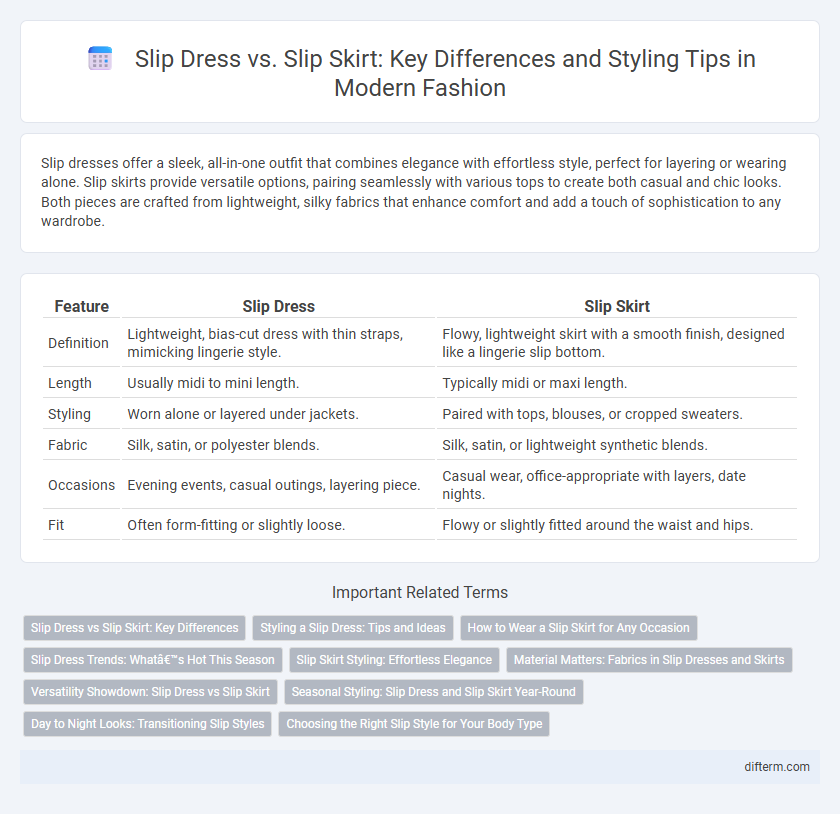Slip dresses offer a sleek, all-in-one outfit that combines elegance with effortless style, perfect for layering or wearing alone. Slip skirts provide versatile options, pairing seamlessly with various tops to create both casual and chic looks. Both pieces are crafted from lightweight, silky fabrics that enhance comfort and add a touch of sophistication to any wardrobe.
Table of Comparison
| Feature | Slip Dress | Slip Skirt |
|---|---|---|
| Definition | Lightweight, bias-cut dress with thin straps, mimicking lingerie style. | Flowy, lightweight skirt with a smooth finish, designed like a lingerie slip bottom. |
| Length | Usually midi to mini length. | Typically midi or maxi length. |
| Styling | Worn alone or layered under jackets. | Paired with tops, blouses, or cropped sweaters. |
| Fabric | Silk, satin, or polyester blends. | Silk, satin, or lightweight synthetic blends. |
| Occasions | Evening events, casual outings, layering piece. | Casual wear, office-appropriate with layers, date nights. |
| Fit | Often form-fitting or slightly loose. | Flowy or slightly fitted around the waist and hips. |
Slip Dress vs Slip Skirt: Key Differences
Slip dresses feature a one-piece construction that combines top and skirt, often with thin spaghetti straps and a smooth, satin or silk fabric that drapes elegantly over the body. Slip skirts are typically separate bottom pieces that can be paired with various tops, offering more versatility and layering options. The key difference lies in the slip dress's all-in-one design for a sleek silhouette, while slip skirts allow for mix-and-match styling in fashion ensembles.
Styling a Slip Dress: Tips and Ideas
Styling a slip dress involves layering with oversized blazers or denim jackets to create a chic, effortless look suitable for both day and night. Pairing the dress with strappy heels or chunky boots adds versatility, while delicate gold jewelry enhances its minimalist elegance. Opt for neutral tones or bold prints based on occasion, balancing comfort with trend-forward aesthetics.
How to Wear a Slip Skirt for Any Occasion
A slip skirt offers versatile styling options that effortlessly transition from casual to formal settings by pairing with fitted tops, blouses, or oversized sweaters. Choosing neutral hues like black, beige, or pastel shades allows for easy coordination with statement accessories and footwear such as ankle boots or strappy heels. Layering the slip skirt under a leather jacket or a tailored blazer enhances its adaptability, making it suitable for office wear, evening events, or weekend outings.
Slip Dress Trends: What’s Hot This Season
Slip dress trends this season highlight satin and silk fabrics in neutral tones, offering a sleek and minimalist aesthetic that complements both casual and formal looks. Designs with delicate lace trims and adjustable spaghetti straps emphasize femininity and versatility, making slip dresses a must-have wardrobe staple. The rising popularity of layering slip dresses over turtlenecks and under blazers showcases their adaptability in transitional fashion styles.
Slip Skirt Styling: Effortless Elegance
Slip skirts offer effortless elegance with their silky fabric and fluid silhouette, making them versatile wardrobe staples. Styling slip skirts involves pairing them with fitted tops or chunky knits for a balanced, chic look perfect for both casual and formal occasions. The ease of layering slip skirts with blazers, boots, or minimal accessories enhances their sophisticated appeal without overwhelming the outfit.
Material Matters: Fabrics in Slip Dresses and Skirts
Slip dresses typically use lightweight fabrics such as silk, satin, and charmeuse that offer a smooth drape and luxurious sheen, enhancing their elegant silhouette. Slip skirts often feature similar materials but may also incorporate blends like polyester or viscose for added structure and durability. Choosing the right fabric impacts comfort, movement, and the garment's ability to maintain its shape throughout wear.
Versatility Showdown: Slip Dress vs Slip Skirt
Slip dresses offer a seamless blend of elegance and ease, making them ideal for both casual and formal settings with their fluid silhouette and adjustable straps. Slip skirts provide versatile layering opportunities, pairing effortlessly with oversized sweaters, tees, or tailored blouses to create diverse looks adaptable to different seasons. The key distinction lies in the slip dress's one-piece design versus the slip skirt's mix-and-match potential, allowing for greater styling creativity and wardrobe flexibility.
Seasonal Styling: Slip Dress and Slip Skirt Year-Round
Slip dresses and slip skirts offer versatile seasonal styling options, seamlessly transitioning from summer to winter wardrobes. Pair slip dresses with strappy sandals and lightweight fabrics for warm months, and layer with turtlenecks, leather jackets, or chunky knits during colder seasons. Slip skirts complement crop tops and blouses in spring and summer, while teaming perfectly with tights, boots, and oversized sweaters for fall and winter.
Day to Night Looks: Transitioning Slip Styles
Slip dresses offer a sleek, all-in-one silhouette ideal for effortless day-to-night transitions, while slip skirts provide versatile layering options for mixing and matching tops. Fabric choices such as silk or satin enhance the elegance of both, enabling easy styling shifts from casual daytime to chic evening looks. Incorporating accessories like a leather jacket or statement heels further elevates these slip styles for diverse occasions.
Choosing the Right Slip Style for Your Body Type
Slip dresses emphasize a sleek silhouette, ideal for tall or slender body types, while slip skirts offer versatile layering options that flatter pear-shaped and hourglass figures by highlighting the waist and hips. Fabrics like silk or satin in both styles create a smooth drape, enhancing curves without bulk. Selecting a slip style that complements your body shape ensures comfort and elevates your fashion statement with effortless elegance.
Slip dress vs Slip skirt Infographic

 difterm.com
difterm.com